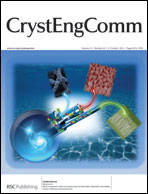Branched twinned Au nanostructures: facile hydrothermal reduction fabrication, growth mechanism and electrochemical properties
Abstract
Multi-twinned Au nanostructures expose more corners and edges than other usual nanostructures. In addition, there are many defects on the surface of the multi-twinned nanostructures, so that they can supply many active sites for electrocatalytic reactions. This paper reports unusual branched twinned Au nanostructures in a facile hydrothermal reduction system based on theoretical analysis and experimental exploring. According to the time-dependent and relative experiments, an etching/re-crystallization growth mechanism is proposed. Besides, the electrochemical investigations suggests that the branched twinned Au nanostructures exhibit enhanced electrocatalytic ORR performance in alkaline media compared with sphere-like Au nanoparticles, because of the higher chemical activity of the corner, edge atoms and defects. Namely, the reduction peak potential of O2 is positive-shifted by 48 mV compared with Au nanoparticles, and the reduction peak current density is 1.45 times that of the Au nanoparticles. Thus, our work enriches the theoretical study of twinned noble metallic nanostructures and accelerates the development of cathodic electrocatalysts for alkaline fuel cells.


 Please wait while we load your content...
Please wait while we load your content...